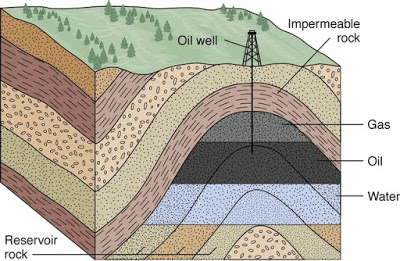An Oil Reservoir is Not a Giant Underground Pool
Contrary to widespread belief, an oil reservoir is not a giant pool of liquid beneath the ground that can easily be sucked onto the surface. Rather, the oil is trapped in the pore spaces between rock crystals and soil grains.
Think of an oil reservoir as a giant sponge soaked in oil. It all comes down to how oil is formed i.e. the burial, compression, and heating of dead organisms underneath sedimentary rocks over millions of years.
Conventional hydrocarbon reservoirs consist of three main parts: The source rock, the reservoir rock, and the cap rock.
- The source rock is the rock that contains the kerogen that the oil and gas forms from.
- The reservoir rock is the porous, permeable rock layer or layers that hold the oil and gas.
- The cap rock seals the top and sides so that the hydrocarbons are trapped in the reservoir, while water often seals the bottom.
Think of an oil reservoir as a giant sponge soaked in oil. It all comes down to how oil is formed i.e. the burial, compression, and heating of dead organisms underneath sedimentary rocks over millions of years.
 |
Conventional hydrocarbon reservoirs |
Reservoir rocks need to be both porous and permeable. This means that there are small pockets of space within the rock where oil or gas can settle and small channels connecting these pockets to allow the oil or gas to flow out of this rock easily when it is drilled. These spaces between grains can develop as the formation of rock occurs or afterward, usually as a result of groundwater passing through the rock and dissolving some of the cement between sediment grains.
Credits: energyeducation.ca

No comments:
Post a Comment